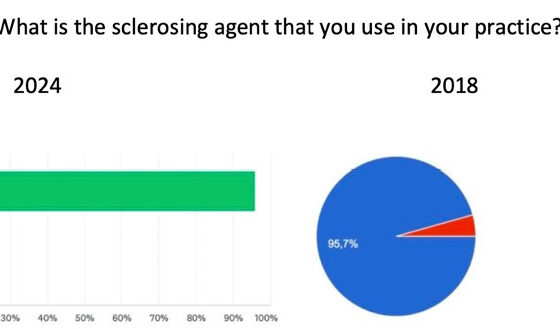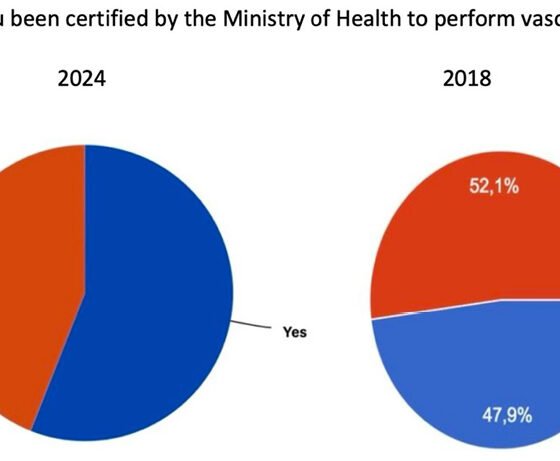The Practice of Ultrasound Guided Foam Sclerotherapy in Varicose Veins of Lower Limbs in Greece During the Years of Economic Crisis, Compared with Today: Have Things Changed

| Available Online: | April, 2024 |
| Page: | 34-38 |
Author for correspondence:
Kosntantinos Seretis
Department of Vascular Surgery, “Korgialenio-Benakio” Hospital of Hellenic Red Cross, Athens, Greece
E-mail: k_seretis@hotmail.com
doi: 10.59037/h3avke72
ISSN 2732-7175 / 2024 Hellenic Society of Vascular and Endovascular Surgery Published by Rotonda Publications All rights reserved. https://www.heljves.com
Konstantinos Seretis, Sophia Tzamtzidou, Dimitra Manou, Nikolaos Giannakopoulos, Konstantinos Roditis, Theofanis Papas
Department of Vascular Surgery, Korgialenio – Benakio Hellenic Red Cross General Hospital, Athens, Greece
Abstract
Full Text
References
Images
Abstract
Abstract:
Introduction: Thermal tumescent interventions emerged during the years of economic crisis in Greece, whereas ultrasound-guided foam sclerotherapy (UGFS) and other endovenous treatments were not widely adopted in Greece because of their increased cost. The aim of this study is to compare the practice of UGFS during the years of economic crisis and today, and find out if there are any changes in terms of technical, medical and economical settings.
Methods: A questionnaire was sent to the members of the Hellenic Phlebological Society and the Hellenic Society of Vascular Surgery, including questions about the technical, medical and economical settings. The collected data were verified, responses were analyzed, and a comparison between the responses given before and after the economic crisis was conducted accordingly.
Results: Technical settings questions were almost the same between the two time periods examined, and it seems that economic crisis didn’t affect the way that the method was applied. Medical settings had some minor changes, and there was a notable increase in the number of cases performed in public hospitals. The greatest difference between the two time periods was found in the economical settings, with a shift from open surgery that was mainly applied in the years of economic crisis, to endovenous procedures that are mainly applied in the post crisis period.
Conclusion: In the years of crisis, endovenous treatments were offered mainly in private hospitals, and open surgery was the method of choice in public hospitals. This treatment strategy has now changed, with modern treatment methods being the 1st line of treatment in both the public and the private sector.
Keywords: vein insufficiency; thermal tumescent interventions; laser ablation, radiofrequency ablation; ultrasound-guided foam sclerotherapy.
Full Text
Introduction
The traditional treatment of Great Saphenous Vein (GSV) incompetence is open surgery, but in the last two decades, endovenous procedures fortreating superficial venous insufficiency have emerged. Endovenous procedures aim to occlude the incompetent GSV by means of thermal energy, chemical irritation, or adhesion, and have gained popularity over open surgery because of their minimal invasive nature. Procedures that utilize thermal energy are called thermal tumescent interventions (EVLA/RFA/EVSA), and are performed using tumescent anesthesia and thermal energy to occlude the incompetent GSV1. More recently, there has been an increasing use of non- thermal treatments for GSV insufficiency that do not require the use of tumescence anesthesia and do not subject individuals to the risk of thermal injury. These techniques are therefore known as non tumescent non-thermal (NTNT) techniques2, and the initial technique of non-thermal interventions for GSV incompetence was that of ultrasound guided foam sclerotherapy (UGFS). Mechanochemical ablation (MOCA) is another NTNT technique which obliterates the venous lumen through the use of a rotating catheter tip that causes mechanical damage, and concomitant injection of a liquid sclerosant that causes chemical injury3. Another NTNT technique is cyanoacrylate embolisation, where occlusion of the incompetent GSV is achieved by means of adhesion after the injection of cyanoacrylate glue within the vein via a hand-held delivery gun4.
Thermal tumescent interventions are the recommended 1st line treatment techniques and UGFS is the recommended second line treatment technique for the treatment of GSV incompetence in the United Kingdom (UK), as per the latest NICE guidance5. Since these techniques emerged during the years of economic crisis in Greece, UGFS and other endovenous treatments were not widely adopted in Greece because of their increased cost. The aim of this study is to compare the practice of UGFS during the years of economic crisis and today, and find out if there are any changes in terms of technical, medical and economical settings.
METHODOLOGY
This is a comparison of the findings depicted in a previous study conducted in 2018 under the auspices of Hellenic Phlebological Society and presented in the annual congress of Societe Francaise de Phlebologie, and a recent study with the same study design applied in today’s every day practice by phlebologists in Greece. According to the study design, a questionnaire was sent to the members of the Hellenic PHlebological Society (HPHS) and the members of the Hellenic Society of Vascular Surgery (HSVS), and included questions about the technical, medical and economical settings. The collected data were verified, responses were analyzed, and a comparison between the two sets of study questions was conducted accordingly.
RESULTS
Technical settings questions were almost the same between the two time periods examined, and it seems that economic crisis didn’t affect the way that the method was applied (Figure 1-6).
Medical settings had some minor changes, and there was a notable increase in the number of cases performed in public hospitals (Figures 7-8).
The greatest difference between the two time periods was found in the economical settings, as it was expected. There has been a shift from open surgery that was mainly applied in the years of economic crisis, to endovenous procedures that are mainly applied in the post crisis period (Figure 9).
Nowadays, the vast majority of treatments for primary truncal varicose veins incompetence is carried out with thermal tumescent techniques, while in the years of crisis open surgery accounted for the 80% of the total cases. NTNT techniques share the same quota in both time periods examined, although UGFS and MOCA, and more recently cyanoacrylate embolization, are the preferred endovenous treatment in an increasing number of physicians because of the lower complication rate that is associated with these techniques.
CONCLUSIONS
Economic crisis deprived modern treatment strategies from Greek patients suffering from chronic venous insufficiency. In the years of crisis, endovenous treatments were offered mainly in private hospitals/clinics, and open surgery was the method of choice in public hospitals. This treatment strategy has now changed, and now that the economic crisis has past, we have aligned with other European Countries and modern treatment methods are now offered to Greek patients as the 1st line of treatment.
References
- Goode SD, Chowdhury A, Crockett M, Beech A, Simpson R, Richards T, et al. Laser and radiofrequency ablation study (LARA study): a randomised study comparing radiofrequency ablation and endovenous laser ablation (810 nm). European Journal of Vascular and Endovascular Surgery 2010;40(2):246-53.
- Mueller RL, Raines JK. ClariVein mechanochemical ablation: background and procedural details. Vascular and Endovascular Surgery 2013;47(3):195-206.
- Leung C, Carradice D, Wallace T, Chetter IC. Endovenous laser ablation versus mechanochemical ablation with ClariVein® in the management of superficial venous insufficiency (LAMA trial): study protocol for a randomised controlled trial. Trials 2016;17(1):421.
- Lane T, Bootun R, Dharmarajah B, Lim CS, Najem M, Renton S, et al. A multi-centre randomised controlled trial comparing radiofrequency and mechanical occlusion chemically assisted ablation of varicose veins – final results of the Venefit versus Clarivein for varicose veins trial. Phlebology 2017;32(2):89-98.
- National Institute for Health and Care Excellence (NICE). Ultrasound-guided foam sclerotherapy for varicose veins. Interventional procedures guidance, IPG440; February 2013. nice.org.uk/guidance/ipg440 (accessed 18 January 2019).











